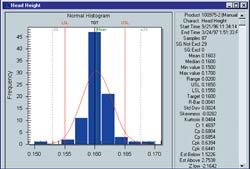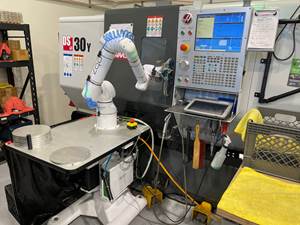Scalable Measurement And Quality
Machine shop owners face a fundamental conflict in their efforts to make metrology an integral part of manufacturing processes. On one hand, the critical relationship between quality and profitability makes metalworking professionals reluctant to change tried-and-true methods. On the other hand, however, the drive for better productivity demands that every aspect of the manufacturing process be rationalized and increasingly divorced from the realm of human subjectivity.
Machine shop owners face a fundamental conflict in their efforts to make metrology an integral part of manufacturing processes. On one hand, the critical relationship between quality and profitability makes metalworking professionals reluctant to change tried-and-true methods. This reluctance is reinforced by the fact that the command language for each type of metrology equipment is likely to be unique and based on the proprietary system of a particular manufacturer. Although the emerging DMIS standard was developed to mitigate this problem, the language barrier continues to complicate efforts to integrate measurement into larger networks.
On the other hand, however, the drive for better productivity demands that every aspect of the manufacturing process be rationalized and increasingly divorced from the realm of human subjectivity. While improvements in machine tools have yielded more automated metalworking processes, measurement and quality control continue to represent detours in many manufacturing operations. Although it’s common for the largest manufacturers to use sophisticated quality control based on Statistical Process Control (SPC) systems, smaller manufacturers and job shop owners may perceive this approach as unnecessary or prohibitively expensive.
Siemens Measurement Systems (Spring House, Pennsylvania) addresses these concerns by offering the Criterion SPC Vantage software tool package. The ten component modules of this suite allow users to establish a complete Quality Information System (QIS) that may be networked company-wide. The software’s open architecture and uniform operator interfaces allow data to be accepted from a variety of sources regardless of the particular format. To facilitate international applicability as well, the major components of this program may be operated in English, German, Spanish and French.
Based on the Windows NT platform, the software is compatible with off-the-shelf PC hardware, third-party measuring devices and CNC controls. The program’s administrative module enables the user to establish classifications and to create data hierarchies for organizing the entire database. A separate data-acquisition module facilitates manual input of information, as well as accepting automatically collected data from predetermined sources. This module automatically categorizes data by product and process, as well as by any number of user-defined tags. It also provides online statistical analysis as data is collected. The software’s analytic module then processes this historical database, creating charts and reports that illustrate quality trends in the ongoing manufacturing process.
The program uses a relational database that can be read by other report writers and query engines. It also generates process capability charts that relate actual output to specific sigma standards. In addition to processing quantitative data, the program also allows inputting qualitative assessments that include non-dimensional measurements such as temperature, pressure, torque and physical attributes.
The Criterion system is scalable for manual, semi-automatic or fully automated operations that comprise various types of measurement devices. This expandable system provides the flexibility to establish a QIS for any size or type of manufacturing operation. The program is designed to integrate numerous types of data into a common system that allows measurement and quality information to be readily accessed and shared throughout a manufacturing organization.
This system provides metalworking professionals with the tools to verify in-process parts and to control the parameters of their manufacturing processes to attain specific quality goals. Assessments of control status and quality trends are made in real time as the data is collected. At regular intervals as desired, a manufacturer may then perform more detailed SPC analysis.
Metalworking professionals who already have begun to integrate measurement and quality functions into their automated processes often discuss the importance of the confidence factor in making this decision. A significant aspect of this confidence consists in the conviction that all components in the manufacturing system will be able to work together. By creating a software package that accommodates a shop’s existing hardware and software systems, Siemens brings sophisticated QIS capability within the reach of many firms.
Related Content
Becoming a More Efficient Shop With the Right Processes and Software
After refining its machining processes for more efficient production, this shop still needed a better way to track its data. Here's how it found a software solution.
Read MoreFinally, A Comprehensive Software Solution Designed for Small Job Shops
Zel X from Siemens is an integrated software application that consolidates collaboration, design, manufacturing, and operations into a comprehensive, easy-to-use solution. From RFQ to delivery, it’s a more efficient way to handle quotes, manage jobs, make parts, and collaborate with teams of all sizes.
Read More5 Tips for Running a Profitable Aerospace Shop
Aerospace machining is a demanding and competitive sector of manufacturing, but this shop demonstrates five ways to find aerospace success.
Read MoreCan Connecting ERP to Machine Tool Monitoring Address the Workforce Challenge?
It can if RFID tags are added. Here is how this startup sees a local Internet of Things aiding CNC machine shops.
Read MoreRead Next
3 Mistakes That Cause CNC Programs to Fail
Despite enhancements to manufacturing technology, there are still issues today that can cause programs to fail. These failures can cause lost time, scrapped parts, damaged machines and even injured operators.
Read MoreThe Cut Scene: The Finer Details of Large-Format Machining
Small details and features can have an outsized impact on large parts, such as Barbco’s collapsible utility drill head.
Read More
















.png;maxWidth=300;quality=90)










